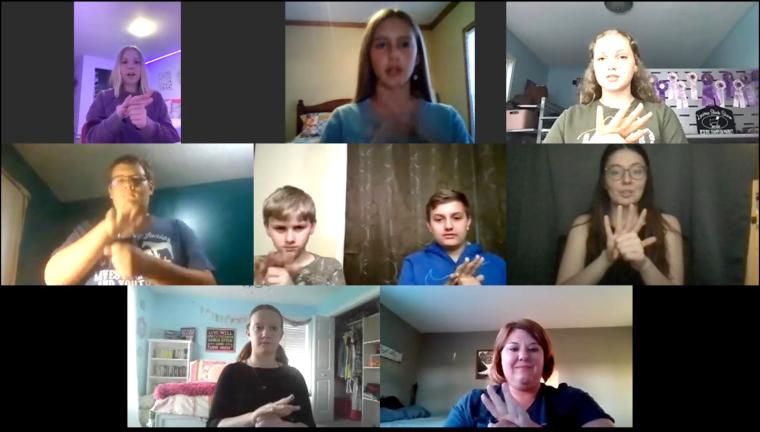KAHOKA, Mo. – Aynsley Harmon, a 12-year-old from Kahoka, Missouri, wanted to be able to talk with a deaf relative she sees at family reunions. So she did what any resourceful 4-H’er does: She looked for a project to help her accomplish her goal.
With a lot of support and collaboration along the way, her determination resulted in a statewide Missouri 4-H project that highlights the best features of university extension and engagement, said Katie Hogan, University of Missouri Extension engagement specialist in 4-H youth development in Clark County.
Missouri 4-H piloted the American Sign Language project this spring for youths grades six and up. Aynsley and the 11 other members of the inaugural online class learned to sign the alphabet, introductions, greetings, feelings, family members and how to answer basic questions. Their final assignment? Reciting the 4-H pledge in ASL.
Aynsley Harmon, Katie Hogan, Nicole Hohlt and others recite the 4-H pledge in American Sign Language.
Two more six-week sessions are already filled, and there is a growing waiting list of dozens of youths from across Missouri.
“I know how frustrated I get when nobody listens to me,” Aynsley said. “I thought about what it would be like to feel that way all the time and not have people understand what I was saying. I think you would feel really alone in the world, and I don’t want anyone to experience that.”
When Aynsley first explored learning sign language, her mother, Ardith Harmon, helped her find online tutorials. Aynsley quickly mastered “basic baby sign language, like thank you and please,” but Ardith Harmon realized they needed help to ensure the quality of the instruction.
The Harmons approached Hogan with the idea of offering ASL as a 4-H project. Hogan saw a chance to build on growing interest in statewide virtual classes available through the Canvas online learning platform.
“This format offers us a way to meet specialized interests that would be hard to replicate in person in individual counties,” Hogan said.
To gauge interest, Hogan and 4-H specialist Sarah Morefield conducted a statewide survey of 4-H’ers age 6 and above. “I received a response from 38 families within the first 24 hours,” Hogan said. “They recognized this is something new and different and not something available in their home communities.”
The response was just as enthusiastic when she reached out for resources at MU and in the deaf community. The project got support from the MU Hearing Clinic, the MU Disability Center and DeafLEAD, a national nonprofit advocacy and services center based in Columbia, Missouri.
In addition to instruction in ASL, youths learn about career possibilities from students and professionals in speech pathology, audiology and interpretation. Starting in fall, youths will be able to register for the ASL project as an event in the 4-H Online system. Missouri 4-H has added ASL in Canvas to the Clover Catalog for 2021-2022.
“This is more than about learning American Sign Language,” Hogan said. “This is about addressing an opportunity gap that exists in many areas around our state where our youth are disadvantaged because they don’t see what else is out there. If we can empower our youth to understand different people and cultures and expose them to other career possibilities, it will help open up their world and future opportunities.”
In the U.S., more than 48 million adults and 30 out of every 1,000 school-age children have hearing loss, said Angela Branson, assistant director at the MU Disability Center. Branson, an ASL interpreter for more than 20 years, helps teach the 4-H class.
“There is such a great need for interpreting services, as well as a need for direct communication with deaf and hard of hearing people in other related professions,” Branson said. “With so many people feeling isolated and not having anyone else to talk with, wouldn’t it be great if there were more Aynsleys of the world to help spread the love a little bit by helping us all learn to connect?”
“Whatever else students take away from this 4-H project, I hope the main idea is inclusiveness,” said DeafLEAD language coordinator Nicole Hohlt. “A lot of times people are afraid when they encounter someone who is deaf, and they end up avoiding that person altogether. My main goal is to let the students know that there is a whole deaf community out there ready to accept and bring them in and teach them their language and culture. This exposure lets the students know that this is exciting and fun and also opens the door to exploring so many career possibilities out there.”
For Aynsley Harmon, one of the best parts of the ASL project — besides looking forward to a more in-depth conversation with her relative — has been realizing so many peers have a similar interest.
Aynsley lives in “a really small community” of about 2,000 residents in far northeastern Missouri. “It’s so cool and amazing to realize that there are other people around the whole state like me who want to learn how to do this, too,” she said. “And now we have the chance.”
Learn more about Missouri 4-H.
Videos:
Aynsley Harmon, Katie Hogan, Nicole Hohlt and others recite the 4-H pledge in American Sign Language, Missouri 4-H Pledge in American Sign Language.
Aynsley Harmon signs her thank you to all volunteers during 4-H’s 2021 Volunteer Appreciation Week, volunteer appreciation week.
Photos:
In these photos, Aynsley Harmon, bottom left, and fellow 4-H’ers practice the reciting the 4-H pledge, led by DeafLEAD’s Nicole Hohlt, middle row, right; and Katie Hogan, MU Extension engagement specialist in 4-H youth development, bottom right.
“Pledge.”
“Service.”
“Heart.”
“Head.”
Writer: Katherine Foran
